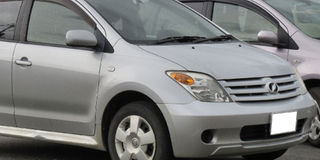Driving the Toyota IST means not worrying about fuel cost

Prossie Kasemire
For the one year and eight months I have had my car, I have never gone to the garage for major repairs. It is easy for me to park in the smallest of spaces but also, easy to join the road. Other road users find it courteous to give space to motorists with smaller cars compared to the big ones that take up more space.
The only problem I have experienced was when the check engine light appeared on the dashboard after hitting a pothole. However, after visiting a service station, an error was discovered and fixed. I have driven a friend’s Toyota Nadia and Toyota Premio but they were a bit too big for me that I had to stick to the IST.
What I do not like about my 2002 five-seater car is the fact that the lights are not bright enough when driving at night. It also does not have charging ports.
I fill the tank at Shs150,000 and this takes me for approximately two weeks. For example, from my home in Kisaasi, Kampala to the city centre, I only use Shs20,000 to and from work.
I would not trade it for any car. On a bad rainy day, I have seen a Toyota Wish struggle to manoeuvre through a slippery road where a Toyota IST drives smoothly.
Joseph Balinda
The Toyota IST is one of the most fuel-efficient, cheap cars to maintain and one of the most compact cars I have driven. With it, I do not have to worry about fuel or servicing even when I am not doing well financially.
I can run on Shs100,000 fuel from Rubaga, a suburb of Kampala to the city centre to work for two weeks. Much as it is suitable for use as a town rounds car, it does not disappoint on the highway regardless of whether it is a murram or tarmack road.
I recently drove it from Kampala to Masaka and it would give me between 11 to 14 kilomeres on one litre of fuel on its 1200cc engine size.
Although it physically looks small, surprisingly, when you fold its rear seats, it can give you space to carry light luggage. However, do not overload it with garden produce such as matooke and other foodstuff like you would do for a pick-up truck since carrying heavy luggage affects and weakens its suspension system.
Service, maintenance
I usually spend about Shs150,000 on service and maintenance. This will cater for things such as replacing brake pads, transmission fluids, engine oil, spark plugs, oil and air filters and other key serviceable parts.
Much as it has enough leg room for not-so-tall drivers and the co-driver, it does not have enough leg room for the passengers. This is the downside of the Toyota IST.
Christopher Oita
I own a 2006 Toyota IST. It is an affordable car to buy and maintain. It is not the most comfortable of cars but it gives you average comfort until you can upgrade to another car. It also has the best mileage since it gives me between nine to 13 kilometres per litre when driving in places with traffic congestion and approximately 16 kilometres on one litre of fuel on the highway.
I stay in Kireka, Kampala, and work in the city centre but fuel worth Shs60,000 is enough to take me through the week if I drive from home to work and back without any diversions.
Although it appears to have low ground clearance, it is better than that of a Toyota Mark X and Mark II, which I have had a chance to drive. It can be driven through rough roads without fear of getting stuck. It is also easy to park.
With maintenance, I visit the garage once in four months, except in cases of a major mechanical fault. On average, its service costs Shs120,000. I source for the spare parts from downtown Kisekka Market and they are readily available.
It is also a car I can comfortably wash myself in less than an hour. This way, I save the Shs10,000 or more I would pay at a washing bay.
However, since I stay a distance off the main road, I have to endure dust, especially during the dry season.
This way, I take more time washing the interior since it absorbs more dust.




